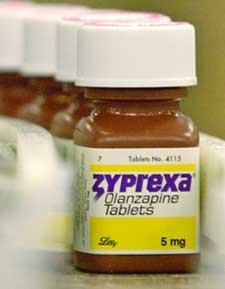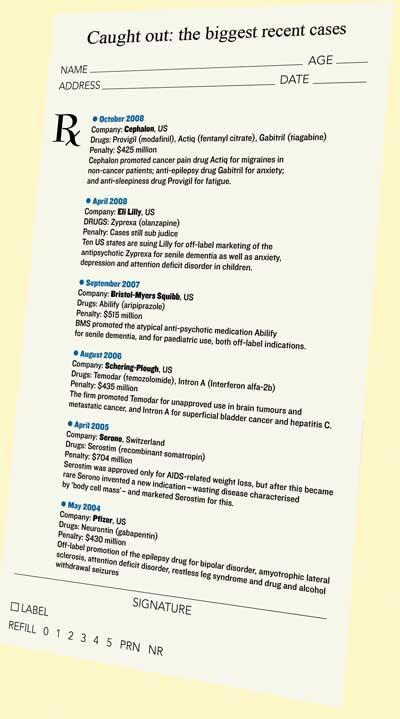One drug can be useful for many different conditions - some of which it isn't licensed for. Peter Mitchell finds out how far is too far when it comes to off-label promotion
One drug can be useful for many different conditions - some of which it isn’t licensed for. Peter Mitchell finds out how far is too far when it comes to off-label promotion
Drug companies operate in a dangerous minefield when they promote off-label uses of their drugs - endorsing their medicines as treatments for conditions they have not received official regulatory approval for. An increasing number of firms have been caught out, receiving heavy fines. So why is the practice so common? And at what point does a drug company cross the boundary between benefiting patients and promoting a drug illegally?

In most jurisdictions, when promoting a drug for its official licensed indications, the manufacturer is only allowed to cite the clinical evidence submitted to the regulatory authorities in support of the licence (in the US this is called a New Drug Application or NDA). Since no such data exists for off-label use, no off-label promotional claims can be made.
But in many cases this rule has been bent or even disregarded altogether - both through the use of educational seminars for doctors, and the unofficial distribution of journal reprints. And critics claim that inappropriate off-label prescribing has led to drug disasters.
A delicate balance
’Unsupported and even dangerous claims and promotional activities always proliferate if the efficacy standard [the standard set by the regulator when reviewing an NDA] is absent,’ says health campaigner Peter Lurie of the US consumer pressure group Public Citizen. ’Recent experience proves that.’
Moreover, according to Lurie, there is growing evidence that peer reviewed medical literature itself has become corrupted by corporate interests. He points to the long-established off-label use of the selective serotonin reuptake inhibitor (SSRI) class of antidepressants for children. ’The objective evidence shows that SSRIs are at best moderately effective in children,’ says Lurie. ’But the published studies have usually exaggerated their benefits. And studies that failed to demonstrate efficacy were withheld from publication by industry-funded academic researchers.’ The effect was to tip the risk-benefit profile of SSRIs in favour of the manufacturer for these off-label uses.
In 2004, after a review of the clinical evidence, European and US drug regulators issued a warning that these antidepressants could actually cause an increase in suicidal behaviour in adolescent children. Seroxat, an SSRI manufactured by UK drug giant GlaxoSmithKline, was banned for use in under-18 year olds.
Another infamous case was that of a class of anti-inflammatory pain medications known as COX-2 inhibitors - the class that includes Merck’s now infamous Vioxx (rofecoxib). Pfizer’s Bextra (valdecoxib) was approved in 2001 for three indications, but it was rejected for the treatment of acute pain. Soon afterwards, Pfizer-sponsored researchers published an article in a dental journal that lauded the drug’s usefulness for acute pain: sales of Bextra increased by 60 per cent in the following three months. (The drug was later voluntarily withdrawn from the market after reports of adverse cardiovascular effects.)
Also in 2001, a leading medical journal published a report suggesting that Pharmacia’s COX-2 inhibitor Celebrex (celecoxib), when used off-label for gastrointestinal ulcers, produced outstanding results after six months. But, says Lurie, the authors didn’t disclose that they already had twelve-month old data showing no advantage for Celebrex compared to the traditional non-steroidal anti-inflammatory drugs it was intended to supersede. ’The published study helped drive the massive Celebrex market,’ says Lurie.
Enforcing the rules

Recent years have seen a spate of government investigations into off-label promotions, in some cases forcing companies to agree very expensive settlements under the US federal False Claims Act. The best known example was Pfizer’s Neurontin (gabapentin), whose sales turned out on investigation to be 90 per cent off-label. The litigation process uncovered that Pfizer had operated a ’publication strategy’ in which marketing firms created studies and assigned the authorship to physicians.
Pfizer eventually paid $430 million (?284 million) to settle the claims. And this was just one example. According to Andrew Jones, senior pharmaceutical analyst at the UK business advisory consultancy Ernst & Young, drug companies have paid the US authorities some $5 billion in penalties for improper sales and marketing practices, of which about half resulted from illegal off-label promotion.
’There is no way to put a pretty face on this, off-label marketing is an illegal activity,’ says Ken Kaitin, director of the Tufts University Center for the Study of Drug Development. ’But it has gone on for many years and the only difference now is the level of enforcement taken against it.’ Companies are willing to bend the rules because they know off-label indications represent such a huge market. ’When they get caught, they pay the price, as Cephalon, Lilly, Purdue Pharma, Pfizer and just about every company at some point has done, whether it is a warning or a fine,’ he says.
Jones says the strong enforcement record in the US should go some way to easing the minds of those who claim loopholes are being exploited. ’It’s noticeable that the major off-label promotion cases ran between September 2005 and the beginning of 2007, since when there has been a drop-off,’ he says. ’That suggests the US regulatory system has been effective in penalising infringers, and that industry has recognised that there are significant penalties attached both in terms of money and public profile.’
Risk and benefit
Yet while companies are rapped on the knuckles for their transgressions, commercial pressures mean they can’t simply abandon off-label promotion. Instead they must somehow build the increasing risk into their business projections, relying on the fact that off-label prescribing - as opposed to promotion - is perfectly legal, and doctors respond angrily to any attempts to restrain it.
Moreover it is an important revenue generator for some drugs. A 2006 study found that 21 per cent of prescriptions for the most commonly prescribed drugs were for off-label uses.1 Off-label prescribing was most common for cardiac and anticonvulsant medications, for which 46 per cent were off-label. An earlier study estimated 115 million off-label prescriptions had been written in the previous year for the 15 highest-selling classes of drugs.2 And some of these prescriptions were based on very little clinical evidence.
For some drugs, promoting off-label use is easily the most successful business strategy - for example gabapentin, as well as many oncology drugs. Moreover there is evidence that the industry has come increasingly to rely on off-label sales in the past few years, as companies struggle to reconcile the difficult and expensive job of pushing new compounds into the front of their pipelines, while trying to prolong the active life of their ageing cash cow products as long as possible.

The case of Lilly’s Zyprexa is a classic example, says Kaitin. Lilly promoted the drug heavily in Miami and other cities highly populated by elderly people, using a marketing campaign ostensibly for Zyprexa’s on-label schizophrenia indication. ’Except that elderly people do not suddenly develop schizophrenia, but they are very prone to depression,’ Kaitin points out. ’The message was clear: this is a drug that can be used for depression. The regulators spotted it and Lilly got its wrists slapped.’
Another favourite technique is to use the media - especially where the new indication is a high-profile one. Consider a company with a drug approved for lung cancer, and then some researcher finds it has some effect in late-stage breast cancer. That’s the cue for the press release and the wonder drug news story. ’That’s going to get front page headlines in most newspapers in the US,’ says Kaitin. ’As a result oncologists will start using that drug immediately for the new indication and it will flourish without any need for approval.’
Oncologists are particularly reliant on using drugs off-label, since time is of the essence in cancer therapy: the doctor must go straight to the drug with the greatest effect immediately, and in many cases that may well be an off-label indication. In fact, says Kaitin, it is not unusual for 60 per cent of prescribing to be off label in cancer, since drugs approved for one indication are actually the treatment of choice for several other tumours. In some cases it can even reach 90 per cent.
A recent study published in The Lancet Oncology recorded some more specific numbers.3 According to that report, between 1990 and 2002, off-label use of anticancer drugs in adults and children ranged between 6.7 per cent and 33.2 per cent - with most of that off-label use in palliative care. Doctors treating patients in the very late stages of cancer must explore every available option to decide on the most effective treatment regime for each individual case.
In the shadows
Kaitin believes it is gradually getting more difficult for companies to get away with covert promotion of off-label use. The regulator’s vigilance is one reason, but another is reimbursement. In the past, in certain areas such as oncology third party payers - including health maintenance organisations (HMOs) and health insurers - used to bend the rules and reimburse for off-label prescribing, but increasingly they are refusing to do so. With the immense price of some of the latest cancer treatments, this places a huge financial burden on the patient - and also means the drug is less likely to be prescribed for that indication.
So why don’t drug companies simply apply to have new indications added to their licences? One simple reason is that to do this they would have to sponsor new trials - an expensive, resource-intensive and time-consuming practice. And at the end of those trials there is no guarantee that the regulatory agency will grant the drug a licence for the new indication. ’Effectively that’s telling all your existing customers not to use the drug for that indication any more, so the company ends up shooting itself in the foot,’ says Kaitin.
As a result, pharmaceutical companies often make the decision not to file a supplementary NDA for a new indication. And sometimes they even announce that decision publicly.
From the pharmaceutical industry’s point of view, it is in a dilemma - whether to concentrate on developing new drugs, or to seek new indications for existing ones. Influenced by the fickleness of investor sentiment, this pendulum has swung several times in the business’s recent history. And at the moment, it is swinging away from off-label promotion.
’From the mid-1990s to the first years of this decade companies focused on life cycle management, seeking new indications to get the most out of their existing portfolio,’ says Kaitin. ’That’s why the industry is only putting out 15 to 16 new products a year, the lowest number of approvals in 25 years, and that’s why it has got into so much hot water with investors.’
According to Kaitin, investor pressure is now pushing big pharma back towards developing new compounds - for economic rather than ethical reasons. The industry has realised that finding a new indication for a product is nowhere near as valuable as finding a new drug. Even though a new indication entitles the company to a patent extension, it cannot stop physicians and health plans buying generic equivalents and prescribing them for the new indication.
The exception will be companies that are very heavily dependent on a single product. With a lucrative franchised drug, a company will do everything in its power to give that drug extra legs to stay in the market, including promoting extra indications.
New rules

This is a critical moment for the industry, as the law governing off-label promotion in the US is about to change. Until 1997, companies were not allowed to do anything at all to encourage or even to inform off-label prescribing. Then the so-called ’Section 401 safe harbour provision’ was introduced. This allowed drug firms to send doctors reprints of peer-reviewed journal articles describing off-label uses of their existing medicines, provided the company was already trying to get the medicine approved for the new indication, and provided it cleared these reprints with the FDA first. However, the Section 401 provision expired in 2006, and it is now once again illegal to promote any off-label uses in any way.
Last year the FDA drafted a consultation paper suggesting that it was minded to reintroduce an exemption equivalent to Section 401. However, the much-feared campaigning congressman Henry Waxman is dead against the idea and is lobbying the FDA to suppress off-label promotion altogether. Waxman, who is chairman of the House Committee on Oversight and Government Reform, has written to FDA commissioner Andrew von Eschenbach claiming that the proposal would ’carve a large loophole in the law’ and damage public health. He has also accused Eschenbach of bowing to industry pressure and loosening controls on off-label marketing: the FDA’s proposals as they stand would not require drug companies either to submit journal articles to the agency, nor even to file a supplementary NDA before distributing journal reprints.
Two key questions dominate the FDA’s deliberations on off-label promotion. First, if a high quality study has been published in a peer reviewed journal, is it really unethical for a drug company employee to draw that paper to a doctor’s attention, without giving him a sales pitch? Previously there has been such an outcry about this type of thing that it was not allowed, but now the FDA says it doesn’t see much wrong with it.

The second question - and the other side of the coin - is this: If the FDA allows companies to promote off-label indications, why in the world would companies ever seek approvals for these indications? ’They would simply file their initial new drug application for the easiest indication, probably a narrow and relatively unimportant one, and then promote the daylights out of the indication that forms the biggest market,’ demurs Kaitin. ’You’d be eliminating the major incentive for companies to seek on-label approvals.’
So the FDA is undoubtedly in a dilemma, exacerbated by the change of administration. Its George W Bush-inspired deregulatory mood may be swept away by Barack Obama. But Lurie of Public Citizen is in no doubt about what the agency should do. ’Every development in the past decade has made the case against off-label promotion still stronger,’ he warns. ’Now the FDA is looking to allow the industry to substitute marketing for science. And it is patients who will bear the brunt.’
Peter Mitchell is a freelance science writer based in Kingston, UK
Further Reading
1 D Radley et al , Arch. Intern. Med., 2006, 166, 1021
2 C Adams and A Young, Risky Rx: a Knight Ridder investigation, Newspaper article series, November 2-4, 2003
3 D Lev?que, Lancet Oncology, 2008, 9, 1102 (DOI:10.1016/S1470-2045(08)70280-8)






No comments yet